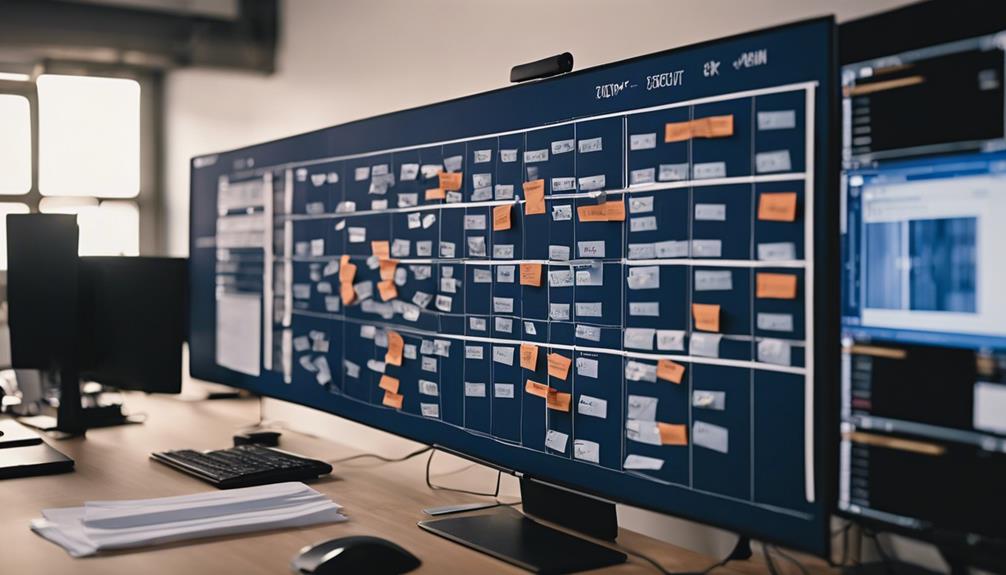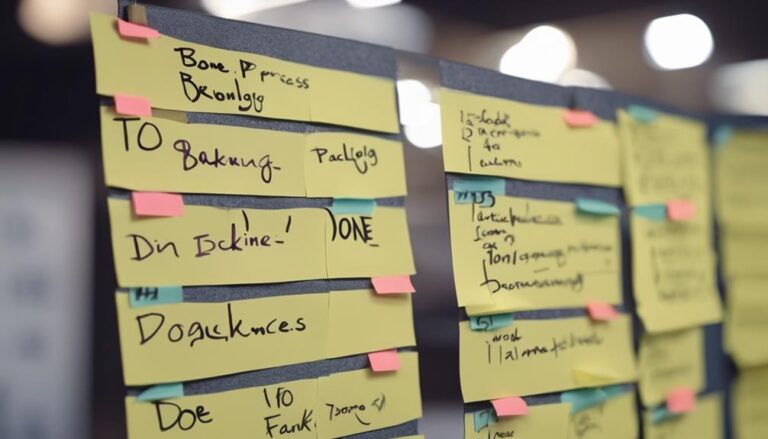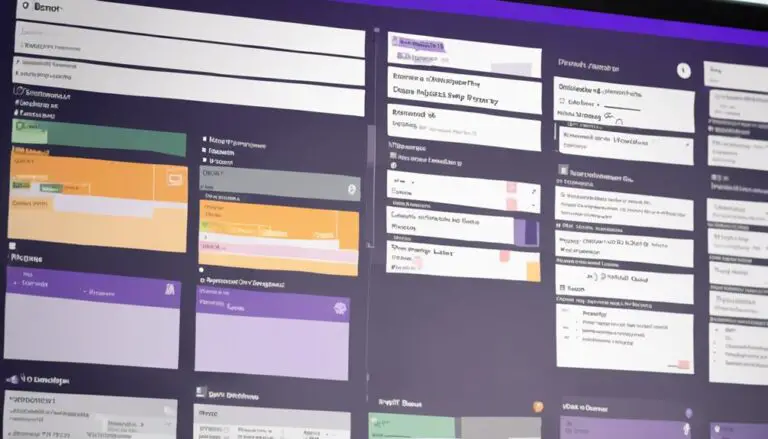When transitioning your Scrum board to a Kanban board in Jira, consider the subtle yet impactful changes required to optimize your workflow. By making strategic adjustments to your board settings and task management techniques, you can enhance efficiency and adaptability.
However, before diving into the technical aspects of this shift, it's crucial to understand the fundamental principles underlying Scrum and Kanban methodologies to ensure a seamless transition that aligns with your team's unique needs.
Stay tuned to discover practical insights on navigating this transformation smoothly and effectively.
Key Takeaways
- Disable sprints and enable backlog for Kanban principles.
- Transition tasks from Scrum board to Kanban backlog.
- Define workflow stages and set WIP limits.
- Visualize workflow, limit WIP, and focus on continuous improvement.
Key Differences Between Scrum and Kanban
When transitioning from a Scrum board to a Kanban board in Jira, understanding the key differences between these two agile methodologies is crucial for optimizing your team's workflow. In Scrum, the focus is on fixed-length iterations known as sprints, where work is completed within a set timeframe. On the other hand, Kanban allows for continuous delivery without predefined time frames, enabling a more flexible approach to managing tasks.
Scrum emphasizes sprint goals and timelines, with specific objectives set for each sprint. In contrast, Kanban concentrates on limiting work in progress (WIP) to enhance flow efficiency, without the constraints of sprint goals. Scrum boards typically have columns like backlog, to do, in progress, and done, while Kanban boards visualize workflow stages without fixed categories, providing a more fluid representation of tasks.
Moreover, Scrum involves sprint planning, review meetings, and retrospectives to ensure progress and adaptation, while Kanban focuses on continuous improvement through visualizing and refining the workflow process. Scrum measures progress using sprint velocity and burndown charts, while Kanban utilizes lead time and cycle time metrics to enhance process efficiency. Understanding these differences will help you make a smooth transition and optimize your team's productivity.
Adjusting Board Settings in Jira
To adjust the board settings in Jira for transitioning from a Scrum board to a Kanban board, begin by accessing the board configuration options. Here are some steps to guide you through the process: In the board configuration options, you can choose to switch the board from a Scrum board to a Kanban board. Once you have made the necessary adjustments, you will be able to manage your work in a more flexible way, with a focus on continuous flow rather than iterative sprints. Additionally, if you ever need to make further changes, such as deleting your Kanban board, you can easily do so by accessing the board configuration options again.
- Disable Sprints: Turn off the sprint functionality on the board settings to align it with Kanban principles.
- Enable Backlog: Activate the Backlog feature to facilitate a smoother transition from Scrum to Kanban.
- Evaluate Workflow Needs: Decide whether to keep or remove the backlog feature based on your team's workflow requirements.
- Ensure Project Access: Verify that the project linked to the Scrum board is accessible and appropriate for the transition to a Kanban board.
- Use Existing Project: There's no necessity to create a new project when converting from a Scrum board to a Kanban board in Jira.
Transitioning Tasks to Kanban Board
Consider creating a new Kanban board in Jira to transition tasks seamlessly from the Scrum board. Before making the transition, ensure that all active sprints on the Scrum board are completed. Move the tasks from the Scrum board to the backlog, allowing for a smooth modification and transfer process to the new Kanban board.
To effectively manage tasks on the Kanban board, analyze the current workflow and define workflow stages. Implement a pull system where team members pull tasks based on their capacity and set up work in progress (WIP) limits to maintain an efficient task management process.
Creating a new Kanban board provides a fresh start for your team to embrace a more flexible workflow. By setting up the board correctly and establishing clear workflow stages and limits, you can enhance your team's productivity and collaboration. Embracing the pull system and WIP limits will help streamline task management and ensure a more efficient workflow on the Kanban board.
Managing Workflow on Kanban Board
To effectively manage workflow on a Kanban board, ensure clear visualization of your team's tasks and workflow stages. Here are some key points to help you effectively manage your workflow on a Kanban board:
- Visualize Workflow Stages: Define and display clear workflow stages on your Kanban board to track task progression efficiently.
- Limit Work in Progress: Enhance productivity by limiting work in progress (WIP) to maintain focus and avoid task overload.
- Implement Pull System: Use a pull system to ensure tasks are pulled only when there's available capacity, promoting a balanced workflow.
- Continuous Improvement: Regularly conduct retrospectives to identify areas for improvement and make necessary process adjustments for enhanced efficiency.
- Track Task Progression: Utilize Jira to monitor and manage task progression effectively, ensuring transparency and accountability within the team.
Improving Efficiency Post-Transition
After transitioning to a Kanban board in Jira, focus on optimizing efficiency by implementing WIP limits to enhance flow and reduce multitasking. Encourage team collaboration to ensure a smooth transition and effective workflow.
Analyze workflow data to pinpoint bottlenecks and areas for improvement, enabling you to make targeted enhancements. Regular retrospectives are vital for gathering feedback and making iterative adjustments, fostering continuous improvement within your team.
Utilize visualization tools like Cumulative Flow Diagrams to track progress and identify trends, aiding in the visualization of workflow dynamics post-transition. By incorporating these strategies, you can boost efficiency, streamline processes, and enhance overall team performance.
Frequently Asked Questions
Can You Convert a Scrum Board to Kanban in Jira?
You can enhance team efficiency and workflow optimization by transitioning from a Scrum to a Kanban board in Jira. Replicate settings, activate Backlog, and adjust filters for smoother project management, task prioritization, and continuous improvement in Agile transitions.
How Do I Transition From Scrum to Kanban?
Transitioning from Scrum to Kanban supports agile transformation, enhancing team collaboration and workflow optimization. Implement lean practices, WIP limits, and a pull system to boost productivity. Embrace agile principles for continuous delivery, process improvement, and agile adoption.
How Do I Switch to a Kanban Board in Jira?
To switch to a Kanban board in Jira, customize your board to reflect your Scrum setup. Optimize workflows for agile methodologies, prioritize tasks, and promote team collaboration. Visualize progress, set work limits, and focus on continuous improvement for efficient project management and team effectiveness.
Can You Change Board Type in Jira?
Yes, in Jira, you can change the board type for board customization, adapting to different Agile methodologies. Make workflow adjustments, collaborate with your team, visualize tasks, manage projects efficiently, configure boards, transform Agile practices, plan sprints, and track work in progress.
Conclusion
Congratulations on successfully transitioning your Scrum board to a Kanban board in Jira! Remember, Rome wasn't built in a day, so be patient as you adjust to the new workflow.
Like a ship changing course, embrace the flexibility and continuous improvement that Kanban offers. Keep refining your process, like a sculptor shaping clay, to enhance efficiency and productivity.
Good luck on your Kanban journey!





